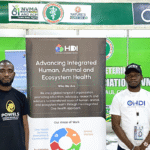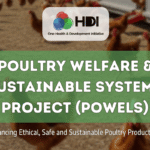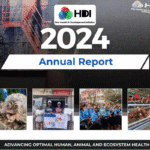One Health Approaches to Reducing Zoonotic Disease Risks from Wildlife Trade and Hunting in the Amazon

Introduction
Emerging infectious diseases (EIDs) pose a significant threat to global public health, with over 60% classified as zoonotic, meaning they can spread between animals and humans. These diseases emerge due to various socio-economic, environmental, and ecological factors. Zoonotic transmission occurs through direct contact with infected animals, contaminated surfaces, vectors, food, or water (Jones et al., 2008) (Morens et al., 2004).
A well-known example is SARS-CoV, where transmission from bats to wild animals likely led to human infection in live animal markets. This underscores the need for understanding wildlife reservoirs and spillover pathways to develop effective disease surveillance, prevention, and control strategies (Wegner et al., 2022).
Wildlife Trade and Bushmeat Hunting: A Public Health Concern
The unsustainable hunting and trade of wildlife for consumption, known as bushmeat hunting, is a critical driver of biodiversity loss and poses a major risk for zoonotic spillovers. Wildlife markets, especially those selling live animals, are potential hotspots for disease emergence. The suspected origin of COVID-19 in a wet market has reinforced concerns about the role of wildlife trade in zoonotic disease outbreaks (Ripple et al., 2016) (Shivaprakash et al., 2021).
The Amazon region, home to diverse wildlife, is significantly affected by these activities. An estimated 38 million animals are illegally traded each year, and annual bushmeat consumption ranges from 67 to 164 million kilograms. Current regulatory frameworks primarily focus on outbreak detection and response rather than proactive prevention of zoonotic spillovers. Strengthening governance related to wildlife trade is crucial to mitigating future pandemic risks (Sinovas et al., 2017) (Karesh et al., 2005).
The One Health Approach: A Holistic Solution
The One Health (OH) approach recognizes the interconnectedness of human, animal, and environmental health. It has been endorsed by international organizations, including the United Nations and the World Health Organization (WHO), as a vital strategy for addressing zoonotic diseases, antimicrobial resistance (AMR), and food safety concerns.
One Health collaborations enhance disease surveillance, improve laboratory capacities, and support integrated control strategies. Initiatives such as the One Health Zoonotic Disease Prioritization Tool (OHZDP) by the CDC and Emerging Pandemic Threats (EPT) by USAID highlight the role of OH in global health security. The Lancet One Health Commission further underscores its significance in policymaking.
One Health Efforts in Amazon Countries
Several One Health initiatives are being implemented across Amazonian countries. The One Health International Network (OHLAIC), established in 2017, fosters collaboration among experts from over 20 Latin American nations. However, awareness and integration of One Health principles vary across the region.
Since 2010, the PREDICT program has conducted disease surveillance in wildlife across Bolivia, Brazil, Colombia, and Peru. In 2012, PREDICT identified a flavivirus outbreak in howler monkeys in Bolivia, prompting a rapid public health response that included vaccination campaigns, community education, and vector control measures (Kelly et al., 2020).
Despite these efforts, challenges remain. A survey conducted between 2018 and 2020 found that while 40% of professionals in Latin America were aware of OH initiatives in their country, many had no knowledge of them, indicating gaps in communication and implementation.
Key Findings from a Scoping Review
The literature review assessed One Health strategies aimed at reducing zoonotic disease risks in Amazon countries (Ramirez & Geffert, 2023). Key findings include:
- Focus on viral reservoirs: Many studies highlighted the role of bats, rodents, and birds as carriers of zoonotic pathogens that could spill over into humans and livestock.
- Priority pathogens: Surveillance efforts have identified RNA viruses such as hantaviruses, arenaviruses, avian arboviruses, and coronaviruses as high-risk for zoonotic transmission.
- Diverse One Health strategies: Literature suggests that One Health approaches range from expert meetings and surveillance programs to legislative actions and international treaties.
- Gaps in implementation: While research recognizes the potential of One Health, practical application in Amazon countries remains inconsistent.
Strengthening One Health in the Amazon
A more comprehensive One Health approach is necessary to effectively reduce the risks of zoonotic diseases from wildlife trade and hunting. Some of these strategies include:
- Strengthening interdisciplinary collaboration: Enhanced cooperation among health, environmental, and wildlife experts can improve surveillance and response strategies.
- Improving public awareness: Community education campaigns on the risks associated with bushmeat consumption and illegal wildlife trade are critical.
- Implementing preventive measures: Stricter regulations and enforcement against illegal wildlife trade can reduce spillover risks.
- Integrating One Health into policy: Governments should adopt One Health principles into national health and environmental policies.
Conclusion
Understanding the connections between wildlife, human health, and the environment is crucial to preventing future zoonotic disease outbreaks. While scientific research provides valuable insights, political action is needed to implement meaningful changes. Strengthening interdisciplinary collaboration, raising public awareness, and enforcing wildlife trade regulations are essential steps toward reducing the risk of emerging infectious diseases. Through a unified One Health approach, we can promote a healthier future for humans and wildlife in the Amazon region.
References
Jones K.E., Patel N.G., Levy M.A., et al. (2008). Global trends in emerging infectious diseases. Nature, 2008 Feb 21;451(7181):990-3. doi: 10.1038/nature06536. PMID: 18288193; PMCID: PMC5960580.
Karesh, W.B., Cook, R.A., BenneƩ, E.L. & Newcomb J (2005). Wildlife Trade and Global Disease Emergence. Emerging Infectious Diseases,11(7):1000-1002. doi: 10.3201/eid1107.040843.
Kelly, T.R., Machalaba, C., et al. (2020). Implementing One Health approaches to confront emerging and re-emerging zoonotic disease threats: lessons from PREDICT. One Health Outlook, Jan 10;2:1. doi: 10.1186/s42522-019-0007-9. PMID: 33824944; PMCID: PMC7149069.
Morens D.M., Folkers G.K. & Fauci A.S. (2004). The challenge of emerging and re-emerging infectious diseases. Nature, Jul 8;430(6996):242-9. doi: 10.1038/nature02759.
Ramirez, N. & Geffert, K. (2023). One Health approaches to reduce the risk of zoonotic disease transmission from wildlife trade and hunting in the Amazon countries: a scoping review. [Unpublished manuscript]. University of Freiburg.
Ripple, W.J., Abernethy, K, et al. (2016). Bushmeat hunting and extinction risk to the world’s mammals. R Soc Open Sci., Oct 19;3(10):160498. doi: 10.1098/rsos.160498. PMID: 27853564; PMCID: PMC5098989.
Shivaprakash, K., Sen, S., Paul, S. et al. (2021) Mammals, wildlife trade, and the next global pandemic. Current Biology, 31(16). doi:10.1016/j.cub.2021.06.057.
Sinovas, P., Price B, et al. (2017). Wildlife trade in Amazon countries: an analysis of trade in CITES-listed species. DOI: 10.13140/RG.2.2.33501.00482.
Wegner, Giulia I., et al. (2022). Averting wildlife-borne infectious disease epidemics requires a focus on socio-ecological drivers and a redesign of the global food system. EClinicalMedicine, 47: 101386. doi: 10.1016/j.eclinm.2022.101386.
Author

Dr. Natalia Ramírez Palomino
Dr. Natalia Ramírez Palomino is a Medical Doctor from Universidad Militar Nueva Granada in Bogotá, Colombia, with over eight years of experience across various medical departments. In 2022, she earned an MSc in Global Urban Health from Albert-Ludwigs-University in Freiburg, Germany, where her master’s thesis focused on “One Health Approaches to Reduce the Risk of Zoonotic Disease Transmission from Wildlife Trade and Hunting in the Amazon Countries: A Scoping Review.”
Since June 2024, Dr. Ramírez has been serving as a Research Associate at Universitätsklinikum Freiburg.











